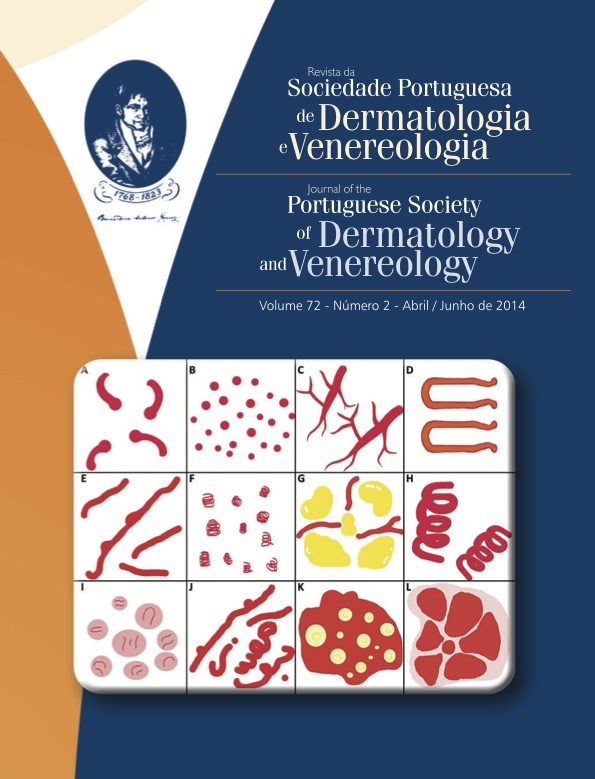SIFILIS SECUNDÁRIA – CORRELAÇÃO CLÍNICO PATOLÓGICA
Resumo
Introdução: Nos últimos anos tem-se verificado um ressurgimento da sífilis. A infecção pelo Treponema pallidum encontra-se sobretudo associada ao uso inconsistente do preservativo e ao elevado número de parceiros sexuais nos meses que precedem o diagnóstico. Na sequência do aumento do número de casos diagnosticados, torna-se premente uma maior sensibilização das características clínico-patológicas da doença. Este artigo descreve e correlaciona as características clínicas e histopatológicas de sífilis secundária em 7 doentes observados no Serviço de Dermatologia do Hospital Santa Maria, em Lisboa, Portugal.
Material e Métodos: Foram estudadas nove biópsias de lesões mucocutâneas de sete doentes com sífilis secundária, observados entre 2009 e 2013, tendo sido correlacionados os achados histopatológicos com os achados clínicos.
Resultados: O presente estudo revelou um largo espectro de alterações histopatológicas que variam desde um infiltrado inflamatório com localização à derme superficial até uma extensão perivascular na derme profunda. Apesar de se verificar alguma correlação entre os diversos padrões de inflamação e o tipo de lesões cutâneas, as lesões maculares associaram-se com um infiltrado inflamatório superficial enquanto as lesões papulares, maculopapulares e nodulares se associaram a um processo inflamatório profundo. O tipo de célula predominante no infiltrado foi o plasmócito. Os neutrófilos foram observados apenas num caso de condylomata lata.
Conclusões: As características histopatológicas de sífilis secundária parecem ser tão variadas como as características clínicas. É da responsabilidade dos profissionais que lidam com estes doentes estarem particularmente atentos à grande variedade semiológica desta patologia, lembrarem-se de o colocar como hipótese diagnóstica clínica e estarem conscientes da necessidade de estabelecer uma estreita interacção com os dermatopatologistas. A colaboração entre patologistas e clínicos permite uma correlação da clínica, serologias e achados histopatológicos de forma a estabelecer mais plausivelmente o diagnóstico de sífilis.
Downloads
Referências
Macaron NC, Cohen C, Chen SC, Arbiser JL. Cutaneous lesions of secondary syphilis are highly angiogenic. Journal of the American Academy of Dermatology. 2003;48(6):878-81.
Pandhi RK, Singh N, Ramam M. Secondary syphilis: a clinicopathologic study. Int J Dermatol. 1995;34(4):240-3.
Alessi E, Innocenti M, Ragusa G. Secondary syphilis. Clinical morphology and histopathology. Am J Dermatopathol. 1983;5(1):11-7.
Hoang MP, High WA, Molberg KH. Secondary syphilis: a histologic and immunohistochemical evaluation. J Cutan Pathol. 2004;31(9):595-9.
Vanconcelos P, Fraga A, Costa JB, Soares de Almeida L, Marques MS. Fenómeno prozona em sífilis secundária. A importância da comunicação entre o clínico e o laboratório. Trab Soc Port Dermatol
Venereol. 2012;70(1):113.
Hernández C, Fúnez R, Repiso B, Frieyro M. Utilidad de la inmunohistoquímica con anticuerpos antitreponema en el diagnóstico de la sífilis. Actas Dermosifiliogr. 2013;104:926-8.
McMillan A, McQueen A, McLaren C. A histopathological
study of secondary syphilis. J Eur Acad Dermatol Venereol. 1996;7(3):235-9.
Todos os artigos desta revista são de acesso aberto sob a licença internacional Creative Commons Attribution-NonCommercial 4.0 (CC BY-NC 4.0).








